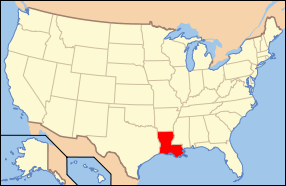Louisiana in the American Civil War
| State of Louisiana | |||||||||
| |||||||||
| Capital | Baton Rouge | ||||||||
| Largest city | New Orleans | ||||||||
| Admission to Confederacy | February 4, 1861 (6th) | ||||||||
| Population | 708,002 Total * 376,276 free * 331,726 slave | ||||||||
| Forces supplied | Total * soldiers * sailors * marines | ||||||||
| Casualties | |||||||||
| Major garrisons/armories | |||||||||
| Governor | Thomas Moore Henry Allen | ||||||||
| Lieutenant Governor | Henry M. Hyams Benjamin W. Pearce | ||||||||
| Senators | Thomas Jenkins Semmes Edward Sparrow | ||||||||
| Representatives | List | ||||||||
| Restored to the Union | July 9, 1868 | ||||||||
| History of Louisiana |
|---|
|
|
|
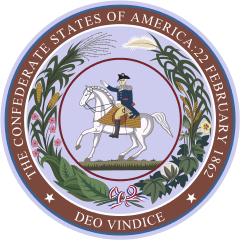 |
|
Confederate States in the American Civil War |
|---|
|
|
| Border states |
| Dual governments |
| Territories |
Antebellum Louisiana was a slave state, where enslaved African Americans had comprised the majority of the population during the eighteenth century French and Spanish colonial period. By the time the United States acquired the territory (1803) and Louisiana became a state (1812), the institution of slavery was entrenched. By 1860, 47% of the state's population were enslaved, though the state also had one of the largest free black populations in the United States. Much of the white population, particularly in the cities, supported southern states' rights and slavery, while pockets of support for the U.S. and its government existed in the more rural areas.
Louisiana declared that it had seceded from the Union on January 26, 1861. New Orleans, Louisiana, the largest city in the entire South, was strategically important as a port city due to its southernmost location on the Mississippi River and its access to the Gulf of Mexico. The U.S. War Department early on planned for its capture. The city was taken by U.S. Army forces on April 25, 1862. Because a large part of the population had Union sympathies (or compatible commercial interests), the U.S. government took the unusual step of designating the areas of Louisiana then under U.S. control as a state within the Union, with its own elected representatives to the U.S. Congress. For the latter part of the war, both the U.S. and the Confederacy recognized their own distinct Louisiana governors.[1]:1–9

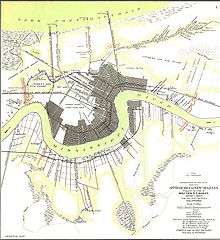
Politics and strategy in Louisiana
Secession
On January 8, 1861, Louisiana Governor Thomas Overton Moore ordered the Louisiana militia to occupy the U.S. arsenal at Baton Rouge and the U.S. forts guarding New Orleans, Fort Jackson and Fort St. Philip. A wealthy planter and slave holder, Moore acted aggressively to engineer the secession of Louisiana from the Union by a convention on January 23. Only five percent of the public were represented in the convention, and the state's military actions were ordered before secession had been established—in defiance of the state constitution, which called for a popular referendum to establish a convention. Moore attempted to justify these actions, saying: "I do not think it comports with the honor and self-respect of Louisiana as a slave-holding state to live under the government of a Black Republican president", using an epithet for Republicans used by many Democrats at the time.
The strategies advanced to defend Louisiana and the other Gulf states of the Confederacy were first, the idea of King Cotton; that an unofficial embargo of cotton to Europe would force Britain to use its navy to intervene in protecting the new Confederacy. The second was a privateer fleet established by the issue of letters of marque and reprisal by President Jefferson Davis, which would sweep the sea clear of U.S. naval and commercial ships, and at the same time sustain Louisiana's booming port economy. The third was a reliance on the ring of pre-war masonry forts of the Third System of American coastal defense, combined with a fleet of revolutionary new ironclads, to safeguard the mouth of the Mississippi from the U.S. Navy. All of these strategies were failures.[4]
In March 1861, George Williamson, the Louisianan state commissioner, addressed the Texan secession convention, where he called upon the slave states of the U.S. to declare secession from the Union in order to continue practicing slavery:
With the social balance wheel of slavery to regulate its machinery, we may fondly indulge the hope that our Southern government will be perpetual... Louisiana looks to the formation of a Southern confederacy to preserve the blessings of African slavery...— George Williamson, speech to the Texan secession convention, (March 1861).[5]
One Louisianan artillery soldier gave his reasons for fighting for the Confederacy, stating that "I never want to see the day when a negro is put on an equality with a white person. There is too many free niggers . . . now to suit me, let alone having four millions."[6]
Union plans
The Union's response to Moore's leveraged secession was embodied in U.S. President Abraham Lincoln's realization that the Mississippi River was the "backbone of the Rebellion." If control of the river were accomplished, the largest city in the Confederacy would be taken back for the Union, and the Confederacy would be split in half. Lincoln moved rapidly to back Admiral David Dixon Porter's idea of a naval advance up the river to both capture New Orleans and maintain Lincoln's political support; by supplying cotton to northern textile manufacturers and renewing trade and exports from the port of New Orleans. The U.S. Navy would become both a formidable invasion force and a means of transporting Union forces, along the Mississippi River and its tributaries. This strategic vision would prove victorious in Louisiana.[7][8]:10–78
Notable Civil War leaders from Louisiana
A number of notable leaders were associated with Louisiana during the Civil War, including some of the Confederate army's senior ranking generals, as well as several men who led brigades and divisions. Antebellum Louisiana residents P.G.T. Beauregard, Braxton Bragg, and Richard Taylor all commanded significant independent armies during the war. Taylor's forces were among the last active Confederate armies in the field when the war closed.[9]
Henry Watkins Allen led a brigade during the middle of the war before becoming the Confederate Governor of Louisiana from 1864–65. Randall L. Gibson, another competent brigade commander, became a postbellum U.S. Senator as a Democrat. Other brigadiers of note included Alfred Mouton (killed at the Battle of Mansfield), Harry T. Hays, Chatham Roberdeau Wheat (commander of the celebrated "Louisiana Tigers" of the Army of Northern Virginia), and Francis T. Nicholls (commander of the "Pelican Brigade" until he lost his left foot at Chancellorsville). St. John Lidell was a prominent brigade commander in the Army of Tennessee.[10]:166 [11]
Henry Gray, a wealthy plantation owner from Bienville Parish, was a brigadier general under Richard Taylor before being elected to the Second Confederate Congress late in the war. Leroy A. Stafford was among a handful of Louisiana generals to be killed during the war. Albert Gallatin Blanchard was a rarity—a Confederate general born in Massachusetts.
Governor Thomas Overton Moore, came held office from 1860 through early 1864. When war erupted, he unsuccessfully lobbied the Confederate government in Richmond for a strong defense of New Orleans. Two days before the city surrendered in April 1862, Moore and the legislature abandoned Baton Rouge as the state capital, relocating to Opelousas in May. Thomas Moore organized military resistance at the state level, ordered the burning of cotton, cessation of trade with the Union forces, and heavily recruited troops for the state militia.[12]
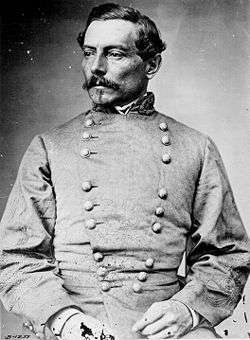
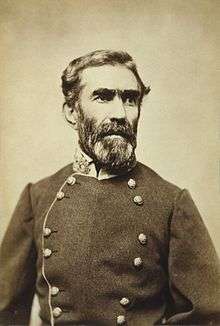
Gen.
Braxton Bragg
Lt. Gen.
Richard Taylor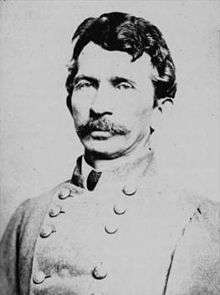
Brig. Gen. and Gov.
Henry W. Allen
Brig. Gen.
Randall L. Gibson
Brig. Gen.
Harry T. Hays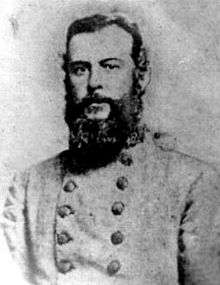
Brig. Gen.
Alfred Mouton
Battles in Louisiana

Battles in Louisiana tended to be concentrated along the major waterways, like the Red River Campaign.
Battle of the Head of Passes
Battle of Baton Rouge
Battle of Bayou Bourbeux (aka Grand Coteau)
Battle of Blair's Landing
Battle of Calcasieu Pass
Battle of Donaldsonville I
Battle of Donaldsonville II
Battle of Fort Bisland
Battle of Fort De Russy
Battle of Forts Jackson and St. Philip
Battle of Georgia Landing
Battle of Goodrich's Landing
Battle of Irish Bend
Battle of Kock's Plantation
Battle of LaFourche Crossing
Battle of Mansfield (aka Sabine Cross-Roads)
Battle of Mansura
Battle of Milliken's Bend
Battle of Monett's Ferry
Capture of New Orleans
Battle of Plains Store
Battle of Pleasant Hill
Siege of Port Hudson
Battle of Stirling's Plantation
Battle of Vermillion Bayou
Battle of Yellow Bayou
Battle of Henderson's Hill
See also
- Category:Louisiana in the American Civil War, linking to various articles on battles, people, and places related to Louisiana during the war years.
- Confederate States of America - animated map of state secession and confederacy
- List of Louisiana Confederate Civil War units, a list of Confederate Civil War units from Louisiana.
- List of Louisiana Union Civil War units, a list of Union Civil War units from Louisiana.
Notes
- Abbreviations used in these notes
- Official atlas: Atlas to accompany the official records of the Union and Confederate armies.
- ORA (Official records, armies): War of the Rebellion: a compilation of the official records of the Union and Confederate Armies.
- ORN (Official records, navies): Official records of the Union and Confederate Navies in the War of the Rebellion.
- ↑ Hearn, Chester G. (1995). The Capture of New Orleans 1862. Louisiana State University Press. ISBN 0-8071-1945-8.
- ↑ ORN I, v. 18, p. 131.
- ↑ Official atlas: plate XC.
- ↑ Hearn, pp. 2-31.
- ↑ Winkler, E.W. (1861). Journal of the Secession Convention of Texas. Texas. Retrieved September 8, 2015.
- ↑ McPherson, James M. (1997). For Cause and Comrades: Why Men Fought in the Civil War. New York City, New York: Oxford University Press, Inc. p. 109. ISBN 0-19-509-023-3. Retrieved April 1, 2016.
- ↑ Chester G. Hearn, The Capture of New Orleans, 1862 (LSU Press, 1995)
- ↑ Johnson, Ludwell H. (1993). Red River Campaign, Politics & Cotton in the Civil War. Kent State University Press. ISBN 0-87338-486-5.
- ↑ Hearn, pp. 22-31.
- ↑ Davis, William C. (1991). Fighting Men of the Civil War. Smithmark Publishers Inc. ISBN 0-8317-3264-4.
- ↑ Hearn, p. 129.
- ↑ Hearn, pp. 2-3.
Further reading
- Ayres, Thomas. Dark and Bloody Ground: The Battle of Mansfield and the Forgotten Civil War in Louisiana (2001)
- Campbell, Anne (2007). Louisiana: The History of an American State. Clairmont Press. ISBN 978-1567331356.
- Dew, Charles B. "Who Won the Secession Election in Louisiana?." Journal of Southern History (1970): 18-32. in JSTOR
- Dew, Charles B. "The Long Lost Returns: The Candidates and Their Totals in Louisiana's Secession Election." Louisiana History (1969): 353-369. in JSTOR
- Dimitry, John. Confederate Military History of Louisiana: Louisiana in the Civil War, 1861-1865 (2007)
- Dufrene, Dennis J. Civil War Baton Rouge, Port Hudson and Bayou Sara: Capturing the Mississippi. Charleston, South Carolina: The History Press, 2012. ISBN 9781609493516.
- Hearn, Chester G. (1995). The Capture of New Orleans 1862. Louisiana State University Press. ISBN 0-8071-1945-8.
- Hollandsworth Jr, James G. The Louisiana Native Guards: The Black Military Experience During the Civil War (LSU Press, 1995)
- Johnson, Ludwell H. Red River Campaign, Politics & Cotton in the Civil War Kent State University Press (1993). ISBN 0-87338-486-5.
- Lathrop, Barnes F. "The Lafourche District in 1861-1862: A Problem in Local Defense." Louisiana History (1960) 1#2 pp: 99-129. in JSTOR
- McCrary, Peyton. Abraham Lincoln and Reconstruction: The Louisiana Experiment (1979)
- Peña, Christopher G. Touched by War: Battles Fought in the Lafourche District. Thibodaux, Louisiana: C.G.P. Press, 1998.
- Peña, Christopher G. Scarred By War: Civil War in Southeast Louisiana (2004)
- Pierson, Michael D. Mutiny at Fort Jackson: The Untold Story of the Fall of New Orleans (Univ of North Carolina Press, 2008)
- Ripley, C. Peter. Slaves and Freedmen in Civil War Louisiana (1976)
- Sledge, Christopher L. "The Union's Naval War in Louisiana, 1861-1863" (Army Command and General Staff College, 2006) online
- Winters, John D. The Civil War in Louisiana. Baton Rouge: Louisiana State University Press, 1963. ISBN 0-8071-0834-0.
- Wooster, Ralph. "The Louisiana Secession Convention." Louisiana Historical Quarterly (1951) 34#1 pp: 103-133.
- Winters, John D. (1963). The Civil War in Louisiana. Baton Rouge: Louisiana State University Press. ISBN 0-8071-0834-0.
External links
| Wikimedia Commons has media related to Louisiana in the American Civil War. |
- National Park Service map of Civil War sites in Louisiana
- First hand accounts of the Civil War in Louisiana.
.svg.png)
.png)
